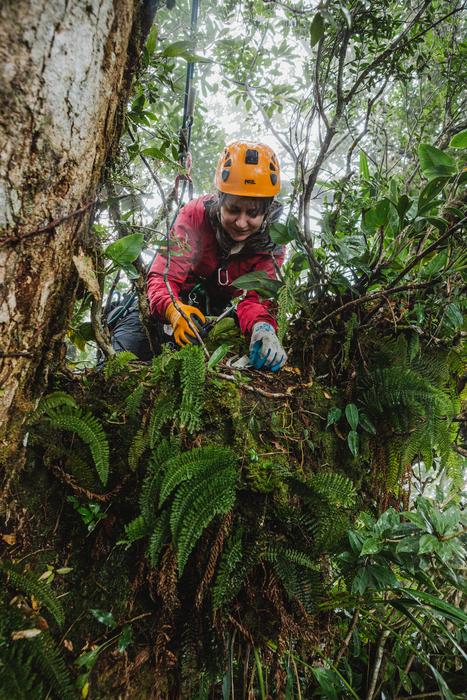In certain trees, soils can form along branches and can support varied plant and animal life. However, what conditions these ‘canopy soils’ form in, and what kind of biodiversity they support, has been difficult to study.

Credit: Marco Molina
In certain trees, soils can form along branches and can support varied plant and animal life. However, what conditions these ‘canopy soils’ form in, and what kind of biodiversity they support, has been difficult to study.
Now, researchers from Utah State University and Imperial College London have surveyed dozens of trees in Costa Rica, mapping the canopy soils to determine where they form and how they might be affected by a changing climate. The results are published in Geoderma.
First author Jessica Murray, from Utah State University, said: “We found canopy soils most often form in cool, foggy areas in these tropical forests where there are large, old trees. Unfortunately, this describes some of the most at-risk forest types, which are threatened by changing climate and deforestation.”
Her PhD supervisor Dr Bonnie Waring, now at the Department of Life Sciences (Silwood Park) at Imperial, added: “Canopy soils in tropical cloud forests are rich in life and nutrients and could be large carbon stores. The fact it’s taken until now to even start to recognise their importance is amazing – not least because we may be destroying them faster than we can study them.”
Unique habitat
To study the soils, Murray climbed trees in six primary (i.e. untouched) rainforest sites in Costa Rica. These included sites along one of the last continuous lines of primary rainforest in South America, with elevations ranging from 67–2700 m above sea level and mean annual temperature ranging from 10–24 ◦C, plus variable rainfall and fog abundance.
She scaled trees up to heights of 15-30m to find canopy soils and measure their biodiversity and soil chemistry. This revealed a great diversity in composition, even along a branch and between trees close to each other – making each soil mat (soil + moss + plants) its “own little forest”.
These forests-in-miniature contain abundant plant and animal life, with invertebrates also supporting varied bird species. The plants include epiphytes – plants that live on other plants – which are especially common in cloud forests.
Canopy soils are nutrient-rich, thanks to mosses that convert nitrogen from the air, meaning the epiphytes that live there are healthier than other types that live directly on tree bark (commonly known as air plants). There is even evidence that the trees themselves take advantage of the soils, growing roots into them to obtain some of the nutrients.
Under threat
The results show canopy soils in general were most abundant in higher, cooler areas with plenty of fog and larger, older trees. While it’s difficult to know exactly how long they take to form, the team estimate some soil mats could take more than a hundred years to reach full maturity.
Unfortunately, this means they could be difficult to replace if they are lost. As the climate heats up, the fog cloud levels are rising in these forests, meaning many soils could disappear and there may not be trees high enough to replace them.
Many such forests have also been logged or face future deforestation, and even where forests have been allowed to recover (secondary forests), few if any would have had sufficient time to regrow mature canopy soils.
Murray said: “Determining the contribution of canopy soils to forest carbon budgets is important for assessing their role in mitigating climate change. It could also be an important marker for recovery: if these soils are crucial for the forest to be an optimum carbon sink, then their formation should be a final marker of a truly recovered forest.”
The rich habitat of canopy soils also means they hold a lot of carbon, and could be an important missing factor in carbon balance models – whether a forest as a whole is releasing or drawing down carbon. To determine the contribution, Murray says the next steps in the research will be to find a way to determine how much canopy soil there is within a landscape, for example via remote sensing.
Dr Waring concluded: “This research shows the value of intact forest ecosystems: restoration of logged forests is important, but some features can’t be put back. We need some policies that focus on preserving landscapes that are ecologically diverse and carbon rich.”
Journal
Geoderma
DOI
10.1016/j.geoderma.2023.116609
Article Title
Climate, as well as branch-level processes, drive canopy soil abundance and chemistry
Article Publication Date
27-Jul-2023




